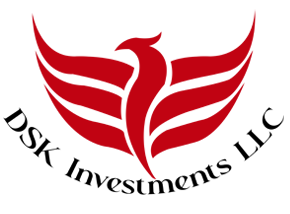
Comprehensive Risk Management Framework
Risk management is an essential aspect of investment strategy at DSK Investments. In the dynamic world of finance, the ability to foresee, assess, and mitigate risks ensures long-term success and stability for our clients. DSK Investments employs a comprehensive and multi-faceted risk management approach designed to protect capital while maximizing returns. Below, we outline the core elements of our risk management process and the strategies we use to navigate an ever-evolving market landscape.
1. Identifying and Assessing Risk
The first step in risk management at DSK Investments is identifying and assessing the various types of risks that could impact investment portfolios. By proactively recognizing potential threats, we can create tailored strategies to mitigate them.
Key Types of Risks We Monitor:
- Market Risk: Exposure to fluctuations in stock prices, interest rates, and foreign exchange rates. This risk affects nearly all investments and is influenced by both macroeconomic factors and market sentiment.
- Credit Risk: The possibility that a borrower will default on its financial obligations, impacting the value of bonds and other debt instruments within the portfolio.
- Liquidity Risk: The risk that an asset or security cannot be sold quickly enough to avoid a loss or take advantage of a new opportunity.
- Operational Risk: Risks arising from internal processes, such as system failures, human error, or fraud, which could lead to financial loss or reputational damage.
- Geopolitical and Regulatory Risk: The influence of political events, regulatory changes, and government interventions that could disrupt markets or affect specific investments.
2. Risk Quantification and Measurement
Once risks are identified, DSK Investments employs various quantitative techniques to measure the potential impact of these risks. This allows us to assess the likelihood of adverse events and the severity of their impact on our portfolios.
Key Risk Measurement Tools:
- Value at Risk (VaR): A statistical technique used to estimate the maximum potential loss of an investment portfolio over a given time period, at a certain confidence level. VaR provides a clear snapshot of the level of risk exposure.
- Expected Shortfall (ES): While VaR calculates the potential loss under normal conditions, expected shortfall provides insights into losses that could occur in extreme scenarios. This helps in understanding tail risk, or the risk of extreme losses during market downturns.
- Beta Coefficient: This measures the volatility of a security or portfolio relative to the overall market. A higher beta indicates greater market risk, while a lower beta implies lower sensitivity to market movements.
- Stress Testing: We run simulations to model how different portfolios might perform under extreme economic or financial conditions, such as recessions, high inflation, or geopolitical tensions.
3. Portfolio Diversification
Diversification is one of the most effective ways to manage risk at DSK Investments. By spreading investments across multiple asset classes, sectors, regions, and currencies, we minimize the impact of any single event on the overall portfolio.
Diversification Strategies:
- Asset Class Diversification: We allocate assets across a wide range of investment vehicles, such as equities, bonds, commodities, real estate, and alternative investments. This helps balance the risk-return profile of the portfolio.
- Geographic Diversification: By investing across different regions and countries, we reduce the exposure to country-specific risks, such as political instability, regulatory changes, or economic downturns.
- Sector and Industry Diversification: We invest in various sectors, such as technology, healthcare, consumer goods, and energy, to ensure that the portfolio is not overly reliant on the performance of any one industry.
- Currency Hedging: For international investments, we use currency hedging strategies to protect against adverse foreign exchange rate movements that could erode returns.
4. Active Risk Monitoring and Management
At DSK Investments, risk management is not a one-time activity; it is an ongoing process that involves continuous monitoring and adjustment of portfolios to address emerging risks.
Active Risk Management Techniques:
- Real-Time Risk Monitoring: Our advanced risk management systems provide real-time monitoring of market movements, portfolio exposures, and performance metrics, allowing for quick adjustments when needed.
- Rebalancing: We regularly review and rebalance portfolios to maintain the desired risk profile. This ensures that as markets move and assets fluctuate in value, the overall portfolio remains aligned with the client’s risk tolerance and objectives.
- Stop-Loss Orders: To limit downside risk, we use stop-loss orders that automatically sell a security when it reaches a certain price, preventing further losses in volatile markets.
- Hedging Strategies: We implement hedging strategies using derivatives such as options, futures, and swaps to reduce risk exposure to particular market events or asset classes.
5. Scenario Analysis and Stress Testing
Scenario analysis and stress testing are critical components of DSK Investments’ risk management process. These techniques allow us to model how portfolios will perform under different market conditions, from mild corrections to extreme economic crises.
Scenario Analysis:
- Macroeconomic Scenarios: We model portfolios under different economic conditions such as high inflation, rising interest rates, and changes in fiscal or monetary policy.
- Market Disruptions: Stress testing for sudden market crashes, geopolitical instability, or unexpected global events (e.g., pandemics, wars) provides insights into how portfolios will withstand shocks.
- Sector-Specific Risks: We assess the impact of regulatory changes, technological disruptions, or environmental policies on particular sectors, ensuring that portfolios are positioned to handle sector-specific risks.
6. Client Risk Tolerance Alignment
At DSK Investments, each client’s risk tolerance is central to our investment process. We begin by assessing individual or institutional risk preferences and then design portfolios that align with those preferences.
Steps in Aligning Risk with Client Objectives:
- Risk Tolerance Assessment: We work closely with clients to evaluate their risk tolerance levels, considering factors such as investment horizon, financial goals, and comfort with volatility.
- Custom Portfolio Construction: Based on the risk assessment, we build bespoke portfolios that balance the client’s desire for growth with their risk tolerance, ensuring that they are comfortable with the level of exposure.
- Continuous Client Communication: We maintain open lines of communication with clients, providing regular updates on portfolio performance and risk levels. This transparency allows clients to feel confident in their investment strategies, even during volatile market conditions.
7. ESG (Environmental, Social, Governance) Risk Considerations
As part of our commitment to sustainable investing, we integrate ESG factors into our risk management framework. ESG risks, such as environmental regulations, corporate governance scandals, and social unrest, can have a significant impact on the long-term performance of investments.
Key ESG Risk Management Approaches:
- Environmental Risks: We assess how climate change, resource scarcity, and environmental regulations could impact companies and sectors within our portfolios.
- Social Risks: Labor practices, community relations, and human rights are factored into our investment decisions to ensure companies are not exposed to reputational or operational risks.
- Governance Risks: Corporate governance, transparency, and ethical leadership are scrutinized to ensure that companies in our portfolios have strong management structures and avoid governance-related scandals.
8. Conclusion: A Proactive Approach to Risk Management
At DSK Investments, risk management is the cornerstone of our investment philosophy. By employing a proactive, comprehensive approach to risk identification, measurement, and mitigation, we ensure that our clients’ portfolios are well-protected in all market environments. Through diversification, advanced risk analysis techniques, real-time monitoring, and continuous client engagement, we are able to deliver strong, risk-adjusted returns while safeguarding capital against unforeseen events.
Our ultimate goal is to build long-term financial security for our clients by staying ahead of risks and adapting quickly to changing market conditions. By integrating ESG considerations and maintaining a client-first approach, we offer investment solutions that are not only profitable but also responsible and aligned with our clients’ broader values.
Dorem ipsum dolor sit amet, consectetur adipiscing elit, sed do eiusmod tempor incididunt labor etteryu dolore magna.Dorem ipsum dolor sit ametng elit, sed do eiusmod tempor incididun tear gorem ipsum dolor sit amet, consectetur adipiscing elit, sed do eiusmod tempor incididunt etteryu dolore magna.Dorem ipsum dolor sit ametng.
Dorem ipsum dolor sit amet, consectetur adipiscing elit, sed do eiusmod tempor incididunt labor etteryu dolore magna.Dorem ipsum dolor sit ametng elit, sed do eiusmod tempor incididun tear gorem ipsum dolor sit amet, consectetur adipiscing elit, sed do eiusmod tempor incididunt etteryu dolore magna.Dorem ipsum dolor sit ametng.
Dorem ipsum dolor sit amet, consectetur adipiscing elit, sed do eiusmod tempor incididunt labor etteryu dolore magna.Dorem ipsum dolor sit ametng elit, sed do eiusmod tempor incididun tear gorem ipsum dolor sit amet, consectetur adipiscing elit, sed do eiusmod tempor incididunt etteryu dolore magna.Dorem ipsum dolor sit ametng.



